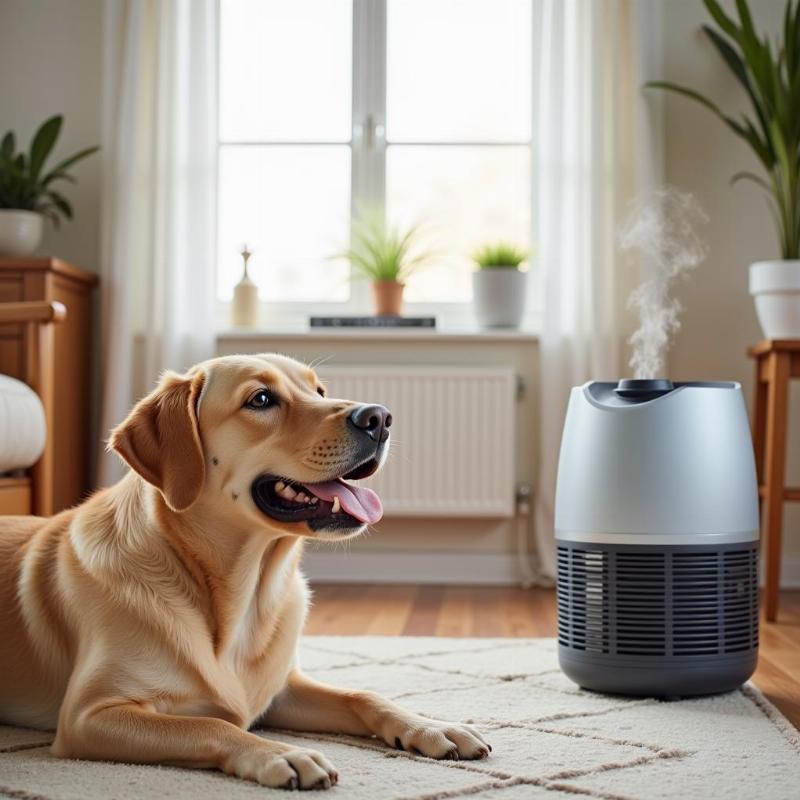Dry skin is a common problem for dogs in the US, and it can be caused by a variety of factors, ranging from environmental conditions to underlying health issues. If your furry friend is constantly scratching, licking, or exhibiting other signs of discomfort, dry skin may be the culprit. This comprehensive guide will delve into the causes, symptoms, and most importantly, effective solutions for how to help dry dog skin.
Understanding the Causes of Dry Skin in Dogs
Several factors can contribute to dry skin in dogs. Arid climates, especially during the winter months when indoor heating is prevalent, can strip moisture from their skin. Just like humans, dogs can suffer from dry skin due to low humidity. Allergies, whether environmental or food-related, can also manifest as dry, itchy skin. Certain breeds, like Bulldogs and French Bulldogs, are more prone to skin issues due to their skin folds. Nutritional deficiencies, particularly a lack of essential fatty acids, can impact skin health. Finally, underlying health conditions like hypothyroidism can also cause dry skin.
Recognizing the Symptoms of Dry Skin
Identifying dry skin in your dog is crucial for prompt treatment. Common signs include excessive scratching, licking, or biting at the skin, particularly on the paws, ears, and flanks. You may notice dandruff, redness, flaking, or even scabbing in severe cases. The fur may appear dull and lifeless, and you might observe hair loss in affected areas.
Effective Solutions for Dry Dog Skin
Addressing dry skin involves a multi-pronged approach. First and foremost, ensure your dog has access to plenty of fresh, clean water. Hydration is key for maintaining healthy skin. Consider adding a humidifier to your home, especially during dry winter months, to increase moisture in the air.
 Using a Humidifier
Using a Humidifier
Dietary Adjustments for Healthy Skin
A balanced diet rich in essential fatty acids, especially omega-3 and omega-6, is essential for skin health. Consult with your veterinarian about incorporating high-quality dog food formulated for skin and coat health, or consider adding fish oil or flaxseed oil supplements to their diet. Avoid feeding your dog table scraps, as certain human foods can exacerbate allergies and skin problems.
Bathing and Grooming Tips
Bathe your dog only when necessary, using a gentle, hypoallergenic shampoo specifically designed for dogs. Over-bathing can strip away natural oils and worsen dryness. After bathing, ensure your dog is thoroughly dried to prevent further moisture loss. Regular brushing can help distribute natural oils and remove loose hair and dander.
Veterinary Care and Treatment Options
If your dog’s dry skin persists despite these measures, consult your veterinarian. They can rule out underlying health conditions and recommend specific treatments. They may prescribe medicated shampoos, topical creams, or oral medications to address allergies or other contributing factors. In some cases, allergy testing may be necessary to identify specific allergens.
Conclusion: Keeping Your Dog’s Skin Healthy and Hydrated
Dry skin can be a nuisance for dogs, but with proper care and attention, it can be effectively managed. By understanding the causes, recognizing the symptoms, and implementing the strategies outlined above, you can help your dog achieve healthy, hydrated, and itch-free skin. Remember to consult with your veterinarian for personalized advice and treatment options if needed. How to help dry dog skin is a multifaceted question, but with the right approach, you can ensure your furry companion stays comfortable and happy.
FAQ:
- How often should I bathe my dog with dry skin? Bathe your dog only when necessary, which could be anywhere from every few weeks to a few months depending on their breed, lifestyle, and the severity of their dry skin.
- What are some good sources of omega-3 fatty acids for dogs? Fish oil, flaxseed oil, and certain types of dog food formulated for skin and coat health are excellent sources of omega-3s.
- Can allergies cause dry skin in dogs? Yes, both environmental and food allergies can manifest as dry, itchy skin.
- Is dry skin a sign of a serious health problem in dogs? While dry skin can be a symptom of underlying health conditions like hypothyroidism, it’s often caused by more common factors like dry air or allergies.
- When should I take my dog to the vet for dry skin? If your dog’s dry skin persists despite home remedies, or if it’s accompanied by other symptoms like excessive scratching, hair loss, or open sores, it’s time to consult your veterinarian.
- What type of shampoo should I use for a dog with dry skin? Use a gentle, hypoallergenic shampoo specifically designed for dogs with dry skin. Avoid using human shampoos, as they can disrupt a dog’s skin pH balance.
- Can I use human lotion on my dog’s dry skin? It’s best to avoid using human lotions on dogs, as some ingredients can be toxic to them. Consult with your veterinarian for safe and effective topical treatments.
Beautdogs.us is your premier online resource for all things dog-related in the US. We provide expert advice on dog breeds, grooming, nutrition, and overall wellness. Whether you’re a seasoned dog owner or just starting your journey with a furry friend, Beautdogs.us is your trusted source for comprehensive and engaging information on dog care. Contact us today for more information! Email: [email protected], Phone: +1 501-555-7529.